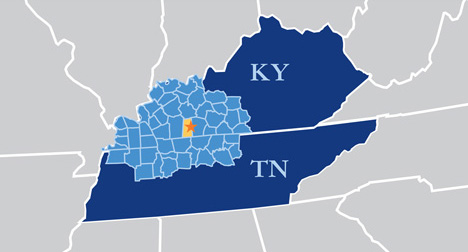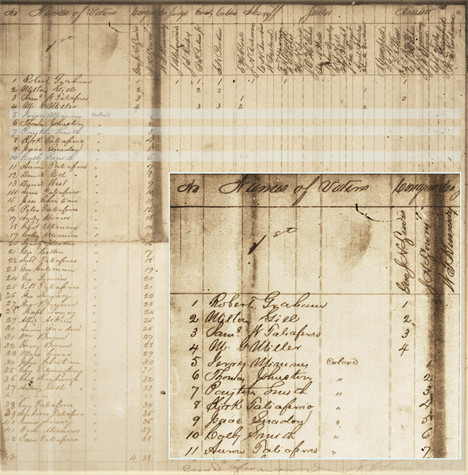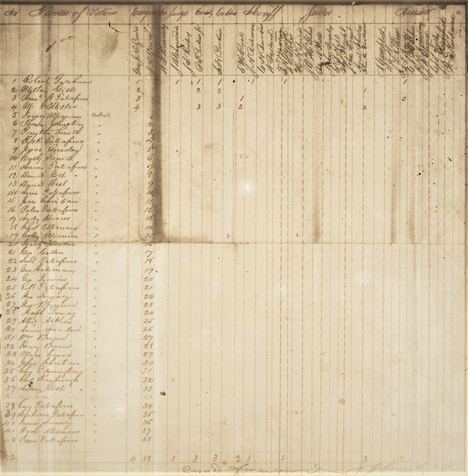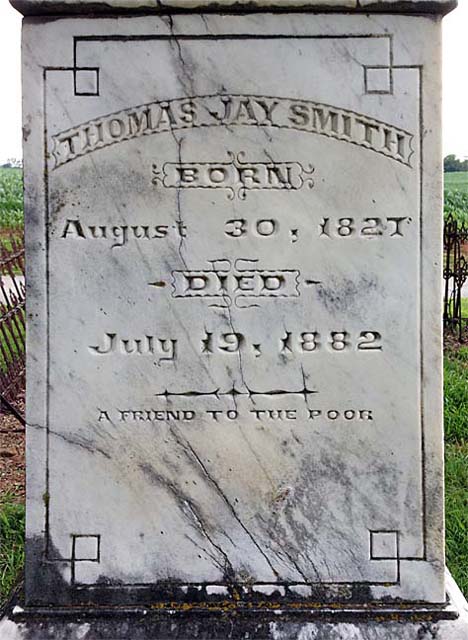


Black Patch Tobacco Country and the Smith Plantation
FindAGrave.com; Suzanne Marshall, Violence in the Black Patch of Kentucky and Tennessee (Columbia: University of Missouri Press, 1994).

1870 Census page showing plantation owners, R. Laprade and Thomas J. Smith, and African Americans, Thomas Sr, Payton, and Colby Smith
August 20, 1870

The first page of the 1870 Hadensville poll book, showing Jerry Mimms and Payton and Colby Smith
August 20, 1870

Joseph H. Lewis in confederate uniform
Public Domain/Wikicommons
A Political Revolution
African-American Men Arrive to Vote, April 25, 1870
Officials cautiously monitored the new African American voters
The April 25, 1870, special election for Kentucky’s 3rd congressional district in western Kentucky was likely the first election in the United States after the 15th Amendment was added to the U.S. Constitution on March 30, 1870. On this day, Todd County was one of nine Kentucky counties in the 3rd district to experience the first large-scale electoral mobilization of African Americans in the United States.
Election clerks at three of Todd County’s ten polling stations on that April day were so alarmed by the participation of the first African American voters that they inscribed in their poll books a code to note each of these newly enfranchised black men. Thomas Jay Smith was the clerk for the Hadensville polling locations, held at the Louisville, Nashville, and Great Southern railway depot. He recorded the name and vote of each man in a four-page poll book and signed each page. He also inserted the code “colored” next to all African American men who came forth and voted.
These black men had never voted before. But the people themselves were not new to Smith because he had close associations with many of them. He knew them, they knew him, and he wrote down their real names, first and last. A few years earlier, clerk Smith may well have owned some of these people and they may have been among the slaves he reported in the 1865 county summer tax audit -- listing them not by their name but by his surname and their value, next to horses and mules.
Challenging the political order
African Americans made up nearly half (78 of 162) the voters at the Hadensville polling station on that April in 1870. After the first four white voters came 50 black men. Polls opened at 6am, sunrise in early April. These 50 former enslaved black men had been waiting in the dark, organized to vote, one by one. As Democratic partisans watched the parade of black voters come forward to vote, and vote Republican, they may well have felt dismay and alarm.
Before the Civil War, Thomas Jay Smith and his family were among the largest owners of African American in the County: Thomas Jay, his brother, Richard Laprade Smith, and their mother, Mary, operated and lived together on a 500-acre plantation outside the small railway town of Hadensville not far from the Elk Fork River. Two months after the end of the Civil War, the Smith family reported still owning 26 people. (In February, 1865 the Kentucky legislature refused to recognize the 13th Amendment abolishing slavery and did not formally adopt the amendment until 1976.)
The Smith plantation grew black leaf tobacco (20,000 pounds in 1860 before the War and exactly the same amount at the end of the War) as its main cash crop. It was a part of the famous “Black Patch” of Kentucky and Tennessee, named for its fire-cured pipe tobacco popular domestically and in Europe. With the expansion of production came slave labor.
Ten years later and Thomas Jay and his brother still owned the tobacco plantation. Twelve of the young boys the Smiths once owned were now of voting age. Given that freed slaves often appropriated the last name of their former owners for various reasons (sometimes because it denoted the truth of biological parentage), it is quite likely that some of the six of the African-American Smiths who voted that day at Hadensville had been Smith family slaves.
The federal census of 1870, taken door by door in the Hadensville rural precinct on August 20 by Assistant Marshall J H Edwards shows three of the African-American voters with the last name Smith. The three men, Thomas Smith Sr, Paton Smith, and Colby Smith, voted in the April election at Hadensville, and were living with their own families right next door to the Smith plantation, which was still owned and run by Thomas J Smith and his brother, Richard Laprade.
In the post-bellum world, Thomas Sr, now listed as age 70, lived with Paton (age 30, presumably his son), Paton’s wife Mary, and their two young children, Maggie and Samuel. Next door was Colby Smith (also age 30), who was perhaps another son of Thomas Sr and thus Paton’s brother, along with his wife Olive and their four children ages 12 to two.
Jerry Mimms lived in the same neighborhood, next door to Colby Smith, one house away from Paton Smith and his family, two houses away from Thomas J and his brother. It was Jerry Mimms who led that the first group of African Americans ever to vote in Hadensville: men who announced, one after another, 50 sequential votes for John H Lowry, the Republican candidate for Congress.
Black enthusiasm continues
Just six months later, the men of Todd County would head once more to the polls to choose their U.S. Representative. In a lower turnout contest, Lewis again prevailed over his Republican rival, though not by as great a margin as in April (634 votes to 556). African Americans turned out disproportionately for Carr, the Republican candidate, making up 40% of voters (but 35% of the eligible electorate). Black voters overwhelmingly voted for Carr (98%) and made up over 80% of Republican voters.
Almost two years later, African American political participation in Todd County remained strong relative to white participation. In August 1872, Todd County voters headed to the polls to elect two key local law enforcement positions (county attorney and sheriff). Across the county, turnout was lower than it had been in 1870. Little more than half of eligible men turned out to vote, with black and white turnout being equivalent (50% vs. 52%). In the town of Elkton, the largest town in the county and the county seat, black turnout was seven points higher than white, with 67% of eligible black men voting and, of those, 99% voting Republican.”
Fast forward another two years, to the November 1874 congressional election, and African American men participated at rates equivalent to white men. The contest between incumbent Franklin Gorin, a Republican elected in a special election earlier in 1874, and his challenger, Democrat Charles W. Milliken, was a low turnout affair (less than a third of eligible voters turned out). However, black voter turnout was equal to white turnout (28% vs. 29%).
Our run of county-wide poll books ends in 1874, though we have poll books for town government elections in the small hamlet of Allensville up to 1886. This means that we do not know how long African American men stood up to the violence and intimidation they faced in the county by attending the polls in Todd County. We do know, however, their valiant participation was insufficient to ensure regular Republican victories, with the Democratic Party dominating Todd County elections for decades.
The story is very different in Garrard County, just a few hundred miles away. There, Republican Party organizers forged an alliance between African Americans and poorer white voters that lasted decades.
1870 Hadensville Voters

Congressional election results from Hadensville, Kentucky. April 25, 1870
The Smiths’ Taxable Property

Property of Thomas J. Smith and his brother, Richard Laprade Smith, according to the Todd County Tax List, showing slaves owned
June 5, 1865








